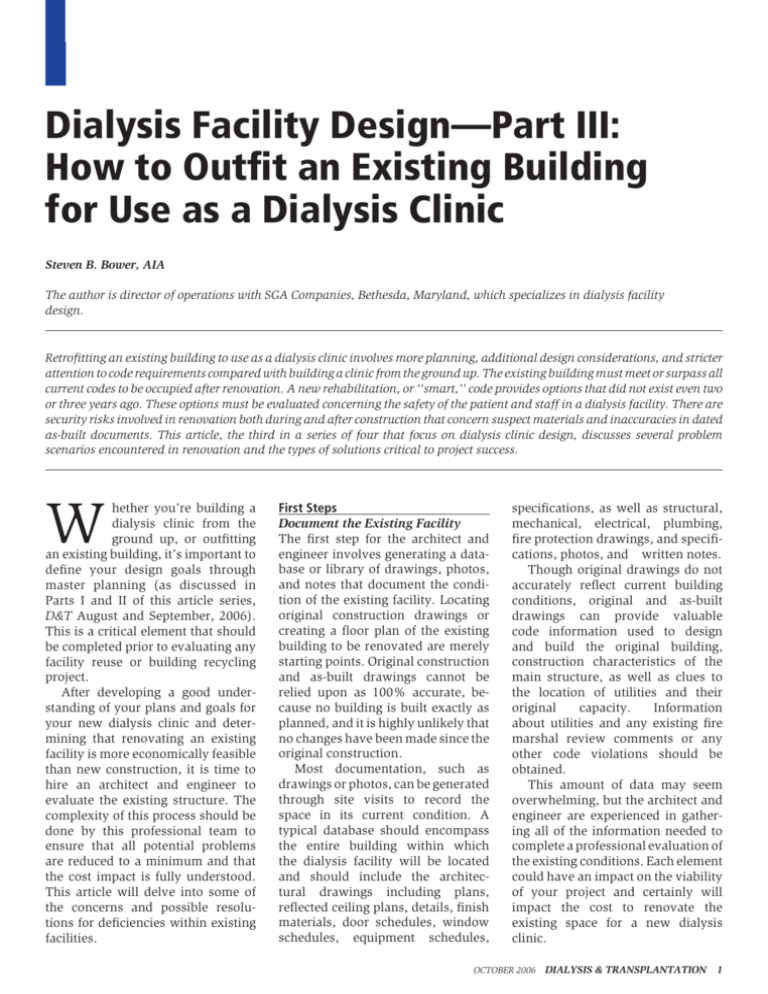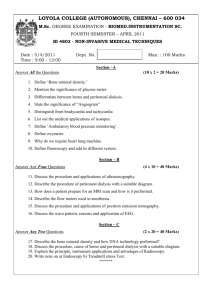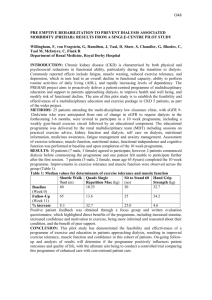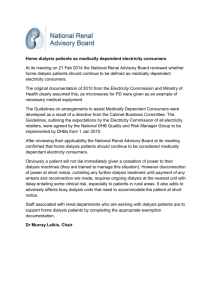Dialysis facility design-part III: How to outfit an existing building for
advertisement

Dialysis Facility Design—Part III: How to Outfit an Existing Building for Use as a Dialysis Clinic Steven B. Bower, AIA The author is director of operations with SGA Companies, Bethesda, Maryland, which specializes in dialysis facility design. Retrofitting an existing building to use as a dialysis clinic involves more planning, additional design considerations, and stricter attention to code requirements compared with building a clinic from the ground up. The existing building must meet or surpass all current codes to be occupied after renovation. A new rehabilitation, or ‘‘smart,’’ code provides options that did not exist even two or three years ago. These options must be evaluated concerning the safety of the patient and staff in a dialysis facility. There are security risks involved in renovation both during and after construction that concern suspect materials and inaccuracies in dated as-built documents. This article, the third in a series of four that focus on dialysis clinic design, discusses several problem scenarios encountered in renovation and the types of solutions critical to project success. W hether you’re building a dialysis clinic from the ground up, or outfitting an existing building, it’s important to define your design goals through master planning (as discussed in Parts I and II of this article series, D&T August and September, 2006). This is a critical element that should be completed prior to evaluating any facility reuse or building recycling project. After developing a good understanding of your plans and goals for your new dialysis clinic and determining that renovating an existing facility is more economically feasible than new construction, it is time to hire an architect and engineer to evaluate the existing structure. The complexity of this process should be done by this professional team to ensure that all potential problems are reduced to a minimum and that the cost impact is fully understood. This article will delve into some of the concerns and possible resolutions for deficiencies within existing facilities. First Steps Document the Existing Facility The first step for the architect and engineer involves generating a database or library of drawings, photos, and notes that document the condition of the existing facility. Locating original construction drawings or creating a floor plan of the existing building to be renovated are merely starting points. Original construction and as-built drawings cannot be relied upon as 100% accurate, because no building is built exactly as planned, and it is highly unlikely that no changes have been made since the original construction. Most documentation, such as drawings or photos, can be generated through site visits to record the space in its current condition. A typical database should encompass the entire building within which the dialysis facility will be located and should include the architectural drawings including plans, reflected ceiling plans, details, finish materials, door schedules, window schedules, equipment schedules, specifications, as well as structural, mechanical, electrical, plumbing, fire protection drawings, and specifications, photos, and written notes. Though original drawings do not accurately reflect current building conditions, original and as-built drawings can provide valuable code information used to design and build the original building, construction characteristics of the main structure, as well as clues to the location of utilities and their original capacity. Information about utilities and any existing fire marshal review comments or any other code violations should be obtained. This amount of data may seem overwhelming, but the architect and engineer are experienced in gathering all of the information needed to complete a professional evaluation of the existing conditions. Each element could have an impact on the viability of your project and certainly will impact the cost to renovate the existing space for a new dialysis clinic. OCTOBER 2006 DIALYSIS & TRANSPLANTATION 1 DIALYSIS FACILITY DESIGN—PART III Codes The first element in an evaluation of this type should be to check the pertinent codes. Most states have now adopted the rehabilitation— or ‘‘smart’’—code, which makes numerous exceptions for reusing an existing space. However, if there is a change of occupancy (or use category), the new sections of the building code will apply to the space. A dialysis clinic will usually be a different use for the building than its previous tenant, and therefore will be classified as a ‘‘new use’’ category with different code requirements. If you are modifying an existing dialysis clinic or other similar medical space, you may be able to use the installation. These are just a few examples—there are numerous other code issues that could impact a specific building. Space Efficiency and Location Evaluate space size and configuration to see if an efficient design can be accommodated. In some cases, columns and bearing walls will decease the design efficiency and require more space than a new design. If a new design is considered 100% efficient and requires 10,000 square feet of space to accommodate 20 patients, and an existing building or space that is an odd shape with poor column spacing is 75% efficient, then the same 20-patient clinic transporting patients through the middle of other public spaces in the building, such as a lobby or by the use of a small business elevator, should be avoided. Determine what specific building uses occupy the spaces above and beneath your new clinic. Water is a large concern for dialysis clinics, and the neighbor below the new space many suffer from any problems that occur. Proper design should minimize their occurrence, but it cannot be guaranteed to eliminate potential problems that can occur with the large amount of heavy water purification equipment. Conversely, a dialysis clinic shouldn’t be located below a noisy tenant or a space Carefully assess the location of the dialysis clinic within a larger building. As with any medical care facility, easy access and visibility is important for patients. Emergency access should also be considered. ‘‘rehabilitation’’ code and the exceptions for existing space. Accessibility Handicapped accessibility is a fundamental concern when designing a healthcare-type facility. There can be major cost and space demands if an existing space has to be retrofitted for a ramp or an elevator needs to be modified. Other items such as public/ patient toilets, doorways, and ‘‘areas of refuge’’ may need to change to accommodate some patients. In most jurisdictions, new facilities require sprinkler systems. Often, when there is a change in occupancy for an existing space, this triggers the requirements for new construction. This can be a rather expensive upgrade in an existing building. The advantage of a sprinkler system is that it may provide enough exceptions to the code requirements that it helps to offset the initial costs of will require 12,500 square feet of space. Develop a test layout to see if the space will meet your goals. This is very important when developing a site analysis, or in this case, a space analysis. Efficient use of the space is not the only planning consideration, as the patient environment is an essential aesthetic issue, in terms of the length of treatment. Exterior light and pleasant views are real patient satisfaction issues. Further, there may be an added staffing cost if the circulation and visibility in the facility is compromised by a less than optimal layout. Another element that should be carefully reviewed is the location of the dialysis clinic within a larger building. As with any medical care facility, easy access and visibility is important for patients. Emergency access should also be considered; 2 DIALYSIS & TRANSPLANTATION OCTOBER 2006 undergoing renovation. The disruption to the patients and staff can be intolerable. Utilities The next items to consider are the utility services. Many office spaces have minimal electric, heating ventilation and air conditioning (HVAC), and plumbing. Determining the size and proximity of the numerous utility systems is very important to maintaining a modest budget. Obviously, with enough money you can overcome almost any building deficiency. Maintaining a real-world economic model for your dialysis clinic is a fundamental requirement, so utility availability is also priority. Many office spaces have very limited or no water supply within the actual lease. Usually, a main water source will need to be located and tested for water quantity. In the past, the actual piping of the water DIALYSIS FACILITY DESIGN—PART III throughout a dialysis clinic was the major cost and installation nightmare. But, new plumbing methods have resolved many of the most costly and difficult installation problems. Today, most new or renovated dialysis clinics use a horizontal access cabinet that is completely accessible and an easy to maintain system. Much like the headwall of a hospital patient room, these horizontal access cabinets can house water supply and drainage, as well as electrical systems, any necessary medical gases, and even HVAC. With an open bottom and a cabinet door for access all the services are easy to maintain and modify if necessary. system that helps clean up most power-quality issues, and even allows some time for an orderly shut down of the equipment. Emergency power equipment should always be carefully considered, as this would allow for a much longer period of power outage as well as the potential to maintain treatment for critically ill patients. Depending on the services provided at each clinic, emergency power may be required for certain critical procedures. The amount of space, the location, and isolation of the emergency generator are important cost considerations. HVAC will need to be carefully analyzed when locating a dialysis Further, the owner should have a list of the level of care that will be provided for the patient. In many clinics, an area for isolation will need to be provided for severely immunedeficient or infectious patients. In some cases, both will need to be provided. The typical renovated facility will not have the correct HVAC system for this type care and a new sub system will need to be provided. The location of the space may make this renovation reasonable costly, or outrageously costly. Due to stringent regulations, the method for obtaining clean outside air and exhausting contaminated air requires a dedicated system for each, The air quality must be checked in an existing space to make sure that contaminates and other organisms do not exist, which may cause problems for immune-deficient dialysis patients. The existing systems may need to be thoroughly cleaned, or even completely replaced. This cabinet can be used to provide television, movies, video games, internet access, telephone, and other electrical services. The main water purification system has also changed dramatically so that today many manufacturers provide equipment that improves with each new model. From a building protection standpoint, it is still important to provide the proper amount of space, isolate that space from the rest of the patient care areas, and waterproof the flooring to protect the areas around and below this large volume of water. Electrical system size and location is not usually a large problem. The main considerations are the quality of electrical service and emergency power which is typically limited in office or retail space. On the quality issue, most new high tech equipment today comes with its own protection clinic within an older existing space. As with any renovation project, the condition of the existing systems and main equipment will need to be tested to verify the air supply for quantity and quality. All engineers will immediately check quantity to make sure the existing systems can heat and cool the space to the proper level. However, this is only the tip of the iceberg when it comes to refitting a dialysis clinic in an older building. The air quality must be checked to make sure that contaminates and other organisms do not exist, which may cause problems for people with immune-deficient systems. The existing systems may need to be thoroughly cleaned or new systems installed to provide the proper air quality to protect both patients and sensitive equipment. completely separate from the standard HVAC system for an office space. These new dedicated systems can greatly increase the cost of the project. As an example, if your new space is located on the ground floor near the entrance of a large sevenstorey building, the only solution may be to run duct work all the way to the roof for an exhaust fan. The intake air will also have to be located at least 10 feet above the ground and at least 25 feet from any other exhaust or automobile fumes so that outside air is free of major contamination. Further Needs There are other issues to consider based on the age or location of the new space you are considering. In buildings more than 25 years old, there is a chance that suspect materi- OCTOBER 2006 DIALYSIS & TRANSPLANTATION 3 DIALYSIS FACILITY DESIGN—PART III als could be present. When a material is considered to be hazardous, such as lead or asbestos, it is classified as a suspect material. Any suspect material will need to be sampled and tested. If a hazardous material is discovered from test results, this material will need to be properly contained and disposed of prior to the start of renovation. The cost of removal should be evaluated against the project budget. In most large cities, security is an issue that needs to be considered and design solutions will need to be developed. The equipment in a dialysis clinic is expensive, as are the electronic conveniences offered to patients. There are numerous electronic systems that can help provide security, with automatic alarms for notifying police. Design considerations can also increase facility security, such as shades on all windows that can be drawn at night to increase security, or a removable or permanent clear acrylic panel installed in the reception. There is a point at which the relationship of the staff to the patient can be compromised by security measures. It is important to explore all options before putting barriers between patients and staff, even if only at the reception area. As was stated earlier, almost every item discussed as an issue can be resolved given enough money, though creative design resolution and forethought through planning plays a large role in maintaining the project budget. When analyzing a potential new space for renovation, 4 DIALYSIS & TRANSPLANTATION OCTOBER 2006 building deficiencies must be evaluated for potential cost impact and solutions prioritized in order to ascertain the true cost of the space. If you just check the lease or purchase cost between one location or another, you may compromise the viability of your project before it even gets to the design phase. By considering the major deficiencies and possible resolutions to obtain a true cost of the space prior to its selection of that space, you will increase the likelihood that the project and the design and construction process will sail on calm seas. Next month: We’ll tackle how to best use color and sound materials in your new clinic for patient and staff safety and comfort.





